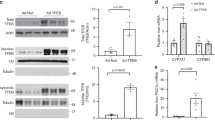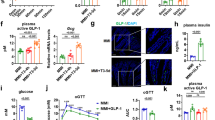Abstract
While bile acids (BAs) have long been known to be essential in dietary lipid absorption and cholesterol catabolism, in recent years an important role for BAs as signalling molecules has emerged. BAs activate mitogen-activated protein kinase pathways1,2, are ligands for the G-protein-coupled receptor (GPCR) TGR53,4 and activate nuclear hormone receptors such as farnesoid X receptor α (FXR-α; NR1H4)5,6,7. FXR-α regulates the enterohepatic recycling and biosynthesis of BAs by controlling the expression of genes such as the short heterodimer partner (SHP; NR0B2)8,9 that inhibits the activity of other nuclear receptors. The FXR-α-mediated SHP induction also underlies the downregulation of the hepatic fatty acid and triglyceride biosynthesis and very-low-density lipoprotein production mediated by sterol-regulatory-element-binding protein 1c10. This indicates that BAs might be able to function beyond the control of BA homeostasis as general metabolic integrators. Here we show that the administration of BAs to mice increases energy expenditure in brown adipose tissue, preventing obesity and resistance to insulin. This novel metabolic effect of BAs is critically dependent on induction of the cyclic-AMP-dependent thyroid hormone activating enzyme type 2 iodothyronine deiodinase (D2) because it is lost in D2-/- mice. Treatment of brown adipocytes and human skeletal myocytes with BA increases D2 activity and oxygen consumption. These effects are independent of FXR-α, and instead are mediated by increased cAMP production that stems from the binding of BAs with the G-protein-coupled receptor TGR5. In both rodents and humans, the most thermogenically important tissues are specifically targeted by this mechanism because they coexpress D2 and TGR5. The BA–TGR5–cAMP–D2 signalling pathway is therefore a crucial mechanism for fine-tuning energy homeostasis that can be targeted to improve metabolic control.
This is a preview of subscription content, access via your institution
Access options
Subscription info for Japanese customers
We have a dedicated website for our Japanese customers. Please go to natureasia.com to subscribe to this journal.
Buy this article
- Purchase on SpringerLink
- Instant access to full article PDF
Prices may be subject to local taxes which are calculated during checkout




Similar content being viewed by others
References
Gupta, S., Stravitz, R. T., Dent, P. & Hylemon, P. B. Down-regulation of cholesterol 7α-hydroxylase (CYP7A1) gene expression by bile acids in primary rat hepatocytes is mediated by the c-Jun N-terminal kinase pathway. J. Biol. Chem. 276, 15816–15822 (2001)
Qiao, L. et al. Bile acid regulation of C/EBPβ, CREB, and c-Jun function, via the extracellular signal-regulated kinase and c-Jun NH2-terminal kinase pathways, modulates the apoptotic response of hepatocytes. Mol. Cell. Biol. 23, 3052–3066 (2003)
Kawamata, Y. et al. A G protein-coupled receptor responsive to bile acids. J. Biol. Chem. 278, 9435–9440 (2003)
Maruyama, T. et al. Identification of membrane-type receptor for bile acids (M-BAR). Biochem. Biophys. Res. Commun. 298, 714–719 (2002)
Makishima, M. et al. Identification of a nuclear receptor for bile acids. Science 284, 1362–1365 (1999)
Parks, D. J. et al. Bile acids: natural ligands for an orphan nuclear receptor. Science 284, 1365–1368 (1999)
Wang, H., Chen, J., Hollister, K., Sowers, L. C. & Forman, B. M. Endogenous bile acids are ligands for the nuclear receptor FXR/BAR. Mol. Cell 3, 543–553 (1999)
Goodwin, B. et al. A regulatory cascade of the nuclear receptors FXR, SHP-1, and LRH-1 represses bile acid biosynthesis. Mol. Cell 6, 517–526 (2000)
Lu, T. T. et al. Molecular basis for feedback regulation of bile acid synthesis by nuclear receptors. Mol. Cell 6, 507–515 (2000)
Watanabe, M. et al. Bile acids lower triglyceride levels via a pathway involving FXR, SHP, and SREBP-1c. J. Clin. Invest. 113, 1408–1418 (2004)
Ikemoto, S. et al. Cholate inhibits high-fat diet-induced hyperglycemia and obesity with acyl-CoA synthetase mRNA decrease. Am. J. Physiol. 273, 37–45 (1997)
Bianco, A. C., Salvatore, D., Gereben, B., Berry, M. J. & Larsen, P. R. Biochemistry, cellular and molecular biology, and physiological roles of the iodothyronine selenodeiodinases. Endocr. Rev. 23, 38–89 (2002)
Holt, J. A. et al. Definition of a novel growth factor-dependent signal cascade for the suppression of bile acid biosynthesis. Genes Dev. 17, 1581–1591 (2003)
Christoffolete, M. A. et al. Mice with targeted disruption of the Dio2 gene have cold-induced overexpression of the uncoupling protein 1 gene but fail to increase brown adipose tissue lipogenesis and adaptive thermogenesis. Diabetes 53, 577–584 (2004)
de Jesus, L. A. et al. The type 2 iodothyronine deiodinase is essential for adaptive thermogenesis in brown adipose tissue. J. Clin. Invest. 108, 1379–1385 (2001)
Hinuma, S. et al. Screening method (method for the screening of agonists or antagonists of TGR5). Japanese patent 2003–380574 (P2005–21151A (JP)). 2005.
Canani, L. H. et al. The type 2 deiodinase A/G (Thr92Ala) polymorphism is associated with decreased enzyme velocity and increased insulin resistance in patients with type 2 diabetes mellitus. J. Clin. Endocrinol. Metab. 90, 3472–3478 (2005)
Mentuccia, D. et al. Association between a novel variant of the human type 2 deiodinase gene Thr92Ala and insulin resistance: evidence of interaction with the Trp64Arg variant of the beta-3-adrenergic receptor. Diabetes 51, 880–883 (2002)
Cohen, D. E. in Hepatology: A Textbook of Liver Disease (eds Zakim, D. & Boyer, T. D.) 1713–1743 (Saunders, Philadelphia, 2003)
Everson, G. T. Steady-state kinetics of serum bile acids in healthy human subjects: single and dual isotope techniques using stable isotopes and mass spectrometry. J. Lipid Res. 28, 238–252 (1987)
Fain, J. N., Reed, N. & Saperstein, R. The isolation and metabolism of brown fat cells. J. Biol. Chem. 242, 1887–1894 (1967)
Branco, M., Ribeiro, M., Negrao, N. & Bianco, A. C. 3,5,3′-Triiodothyronine actively stimulates UCP in brown fat under minimal sympathetic activity. Am. J. Physiol. 276, E179–E187 (1999)
Picard, F. et al. SRC-1 and TIF2 control energy balance between white and brown adipose tissues. Cell 111, 931–941 (2002)
Curcio, C. et al. The human type 2 iodothyronine deiodinase is a selenoprotein highly expressed in a mesothelioma cell line. J. Biol. Chem. 276, 30183–30187 (2001)
Sakakura, H. et al. Simultaneous determination of bile acids in rat bile and serum by high-performance liquid chromatography. J. Chromatogr. 621, 123–131 (1993)
Acknowledgements
We thank S. Iwasaki, A. Izumi, T. Taniguchi, K. Sakai, G. Tsujimoto, Y. Kawamata, H. Overmars, T. Sorg, M.-F. Champy and the staff of the Institut Clinique de la Souris for technical assistance and discussions. We also thank Seahorse Bioscience for the collaborative studies of oxygen consumption and extracellular acidification rate in the human skeletal myocytes. Work in the laboratories of the authors is supported by grants from CNRS, INSERM, ULP, FRM, the Hôpital Universitaire de Strasbourg, the NIH, EMBO and the EU. Author Contributions M.W. and S.M.H. were involved in project planning, experimental work and data analysis; C.M., M.A.C., B.W.K., H.S., N.M., J.W.H., O.E., T.K. and K.S. performed experimental work; and A.C.B. and J.A. were involved in project planning and data analysis.
Author information
Authors and Affiliations
Corresponding author
Ethics declarations
Competing interests
Reprints and permissions information is available at npg.nature.com/reprintsandpermissions. The authors declare no competing financial interests.
Supplementary information
Supplementary Notes
This file contains Supplementary Tables 1 and 2, Supplementary Methods and Supplementary Figure Legends. (DOC 59 kb)
Supplementary Figure 1
A comparison of results after the different diets. (PDF 98 kb)
Supplementary Figure 2
a, Hematoxylin and eosin stained epWAT and BAT sections in animals treated with the indicated diets. b, Osmium tetroxide stained BAT sections of wildtype and D2-/- mice. (PDF 844 kb)
Rights and permissions
About this article
Cite this article
Watanabe, M., Houten, S., Mataki, C. et al. Bile acids induce energy expenditure by promoting intracellular thyroid hormone activation. Nature 439, 484–489 (2006). https://doi.org/10.1038/nature04330
Received:
Accepted:
Published:
Issue Date:
DOI: https://doi.org/10.1038/nature04330



